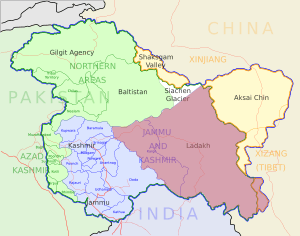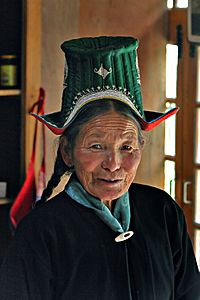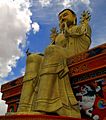Ladakh facts for kids
Quick facts for kids
Ladakh
|
|
|---|---|
|
Region
|
|

The Walna river, Wanla village, Zanskar
|
|

Map showing Ladakh, in pink. The rest of Kashmir under Indian control is shown in blue and Siachen Glacier in white.
|
|
| Countries | India/Pakistan |
| Division | Jammu and Kashmir |
| Districts | Kargil, Leh |
| Area | |
| • Total | 49,146 km2 (18,975 sq mi) |
| Population
(2001)
|
|
| • Total | 270,126 |
| • Density | 5.49640/km2 (14.23561/sq mi) |
| Languages | |
| • Official | Ladakhi, Tibetan, Kashmiri, Urdu, Balti |
| Time zone | UTC+5:30 (IST) |
| Vehicle registration | Leh:JK10/Kargil:JK07 |
| Main cities | Leh/Kargil |
| Infant mortality rate | 19% (1981) |
| Website | , |
Ladakh (Standard Tibetan: ལ་དྭགས Urdu: لدّاخ) is a special region in northern India. Its name means "land of high passes". It is part of the state of Jammu and Kashmir. Ladakh sits between the Kunlun range in the north and the main Himalayas to the south.
This area is famous for its amazing mountain views. It is home to people from both Indo-Aryan and Tibetan backgrounds. Their language is an old form of Tibetan. Because of its strong Tibetan culture, Ladakh is often called "Little Tibet". It is one of the least populated regions in the area.
In the past, Ladakh was a very important place for trade. Many key trade routes met there. But in the 1960s, China closed its border with Tibet. This made international trade much harder. However, Tourism has grown a lot since 1974. It is now very important for Ladakh's economy. The Indian military has a strong presence here. This is because the wider region is part of a border area.
The biggest town in Ladakh is Leh. It is one of the few places in South Asia where Buddhism is still very strong. Most people in Ladakh are Tibetan Buddhists. The rest are mostly Shia Muslims. Kargil is the second largest town. Some local activists want Ladakh to become a separate union territory. They feel this way because of its different religions and cultures compared to Kashmir, which is mostly Muslim.
Contents
Geography and Rivers
Ladakh is the highest plateau in Jammu and Kashmir. Much of it is over 3,000 meters (9,800 feet) above sea level. It covers parts of the Himalayan and Karakoram mountain ranges. It also includes the upper Indus River valley.
The Indus River is very important to the people of Ladakh. Most major towns, like Shey, Leh, Basgo, and Tingmosgang, are near the Indus River. The part of the Indus River that flows through Ladakh is the only part of this river in India. This river is considered sacred in Hindu culture.
People and Culture
| Religions in Ladakh | ||||
|---|---|---|---|---|
| Religion | Percent | |||
| Islam | 47.39% | |||
| Buddhism | 45.86% | |||
| Hinduism | 6.22% | |||
The people of Ladakh are quite unique. Their faces, bodies, and clothes look more like those from Tibet and Central Asia than from other parts of India. The first people here might have been Dards. They were an Indo-Aryan group from the Indus and Gilgit areas.
About 46% of Ladakhis are Buddhist. Just over 47% are Muslim, and 6% are Hindu. Kargil District is the only district in Ladakh where most people are Muslim.
Many Ladakhis traditionally lived a nomadic life, moving with their animals. About 90% of them now depend on agriculture. They grow crops using water from the Indus River. Main crops include barley, wheat, buckwheat, peas, and beans. Apples and apricots grow in warmer, lower areas.
Occupations and Trade
Another important job is raising sheep. The herdsmen are called Chang-pas. They raise goats and sheep with long hair. From their soft under-fleece, the famous Kashmiri Pashmina shawls are made. Chang-pas live in tents and move around to find good places for their animals to graze.
People in Ladakh are also very interested in trade. Raw wool is their main product to sell. Men travel far to get good prices for their goods. These include salt, dried fruits, pearls, and semi-precious stones. In return, they buy tea, tobacco, grain, sugar, and other important items.
Sports and Adventure
Playing polo on fast ponies is the most popular sport in Ladakh. Unlike Western polo, players use the same sturdy pony for the whole game. They still use simple wooden balls and play on rough fields. Polo is still very popular in Ladakh.
Ladakh is also a great place for adventure. Hunters can find animals like the markhor, ibex, red bear, snow leopard, wild sheep, antelope, gazelle, and marmot. Ladakh also has minerals like gold, copper, and semi-precious stones.
For mountain climbers, Ladakh offers exciting treks. These include the Chadar Trek, also known as the frozen Zanskar river trek. Another is the Stok Kangri Trek, which reaches 6,153 meters (20,182 feet). Climbers can experience climbing the highest peak in the Stok Range of the Himalayas here.
Animals of Ladakh
Ladakh is home to many unique wild animals. You can find the black-necked crane here. These birds come to India every year to breed. Other animals include the markhor, ibex, red bear, snow leopard, wild sheep, antelope, gazelle, and marmot. Yaks are also common in Ladakh.
Images for kids
-
The black-necked crane comes to India every year for breeding. Photograph has been taken at Tso Kar, Ladakh.
-
Yaks in Ladakh
-
Street market in Leh
-
Statue of Maitreya at Likir Monastery, Leh district
-
Carved stone tablets, each with the inscription "Om Mani Padme Hum" along the paths of Zanskar
See also
 In Spanish: Ladakh para niños
In Spanish: Ladakh para niños











































